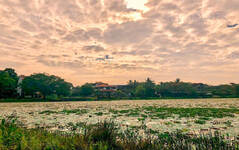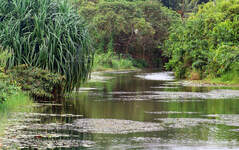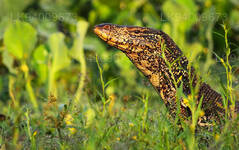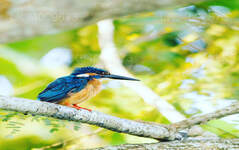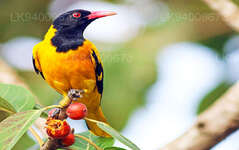
Ciudad de Colombo
Colombo, la capital de Sri Lanka, es una ciudad dinámica que combina tradición y modernidad. Luce arquitectura colonial, mercados animados y tranquilos templos budistas. Con una gastronomía diversa, un horizonte en crecimiento y hermosas playas, es un vibrante centro de negocios, cultura y turismo, ofreciendo una puerta de entrada para explorar las maravillas de Sri Lanka.
Talangama Wetland
The Thalangama Wetlands are the swamps surrounding the lake, which is located in the Thalangama area of Battaramulla. It’s quite shocking to realize that this haven of nature lies less than an hour outside the busy commercial center of Colombo.
What is a Wetland?
The Ramsar Convention (an international treaty for the conservation and suitable utilization of wetlands) defines the word wetland as ‘areas of marsh, fen, peatland or water, whether natural or artificial, permanent or temporary, with water that is static or flowing, fresh, brackish or salt, including areas of marine water the depth of which at low tide does not exceed six meters’. Wetlands can help in the mitigation of floods, offer protection from storms, help in the retention of sediment, act as a carbon sink, and be an excellent purifier of water.
About the Thalangama Wetlands
The Thalangama lake itself was manmade several centuries ago for irrigation purposes, and is surrounded by numerous paddy fields, canal, ponds and marshes. It supports a rich ecosystem that hosts thousands of species of exotic flora, over a hundred different species of birds, several species of butterflies and dragonflies, a few species of damselflies, reptiles and amphibians, and some small mammals. Given below is a list of confirmed sightings in some of the categories.
Birds
- Purple Swamphen
- White-breasted Waterhen
- Common Moorhen
- Pheasant-tailed Jacana
- Little Grebe
- Little Cormorant
- Cattle Egret
- Little Egret
- Intermediate Egret
- Oriental Darter
- Purple Heron
- Grey Heron
- Little Green Heron (Striated Heron)
- Indian Pond Heron
- Black-crowned Night- Heron
- Little Heron
- Oriental Honey-buzzard
- Red-wattled Lapwing
- Black Bittern
- Yellow Bittern
- Asian Open-bill
- Painted Stork
- Black-headed Ibis
- Glossy Ibis
- Lesser Whistling Teal
- Cotton Pigmy Goose
- Pied Kingfisher
- Common Kingfisher
- White-Throated Kingfisher
- Stork-billed Kingfisher
- Common Sandpiper
- Kentish Plover
- Lesser Sand Plover
- Golden Plover
- Marsh Sandpiper
- Common Redshank
- Common Greenshank
- Wood Sandpiper
- Curlew Sandpiper
- Black-winged Stilt
- Little Stint
- Imperial Green Pigeon
- Emerald Dove
- Spotted Dove
- Greater Coucal
- Rose-ringed Parakeet
- Asian Koel
- Indian Scops-owl
- Collared Scops-owl
- Brown Hawk-owl
- Little Green Bee-eater
- Ceylon Small Barbet
- Indian Pigmy Woodpecker
- Lesser Yellownape
- Black-rumped Flameback
- White-browed Bulbul
- Indian Pitta
- Barn Swallow
- Forest Wagtails
- Yellow Wagtails.
- Pintailed Snipe
- Kora (Watercock)
- Blue-tailed Bee-eaters
- White-backed Munia
- Dark-fronted Babblers
- Black-headed Munia
- Asian Paradise-Flycatcher
- Indian Swiftlets
- Little Swift
- Shikra
- Serpent Eagle
- Honey-buzzard
- Brown Shrike
- Black-headed Cuckooshrike
- Ceylon Green-Pigeon
- Petrel
- Pelican
- Black-hooded Oriole
- Yellow-billed Babbler
Dragonflies
- Blue-eyed Pondcruiser (Epophthalmia vittata)
- Rapacious Flangetails (Ictinogomphus rapax)
- Sombre Lieutenants (Brachydiplax sobrina)
- Spine-legged Redbolts (Rhodothemis rufa)
- Scarlet Baskers (Urothemis signata)
- Green Skimmer (Orthetrum sabina)
- Blue Pursuer (Potamarcha cogener)
- Elusive Adjutant (Aethrimanta brevipennis)
- Yellow Waxtail (Ceriagrion coromandelianum)
- Painted Waxtail (Ceriagrion cerinorubellum)
- Sapphire Flutterer (Rhyothemis triangularis)
Reptiles, Amphibians and Mammals
- Water Monitor
- Purple-faced Leaf Monkey
- Indian Porcupine
- Brown Mongoose,
- Palm Civet Cat
- Fishing Cat
- Otter
- Moose Deer
Things to do at the Thalangama Wetlands:
- Birdwatching ( Start early in the day. Bring your binoculars and cameras. Average sightings for a Half-Day Birdwatching Tour – 60 to 70 species )
- Butterfly/Dragon Fly Watching
- Nature Tour
- Jogging
- Cycling
While enjoying the nature make sure that you take only photos and memories, and leave only your footsteps. Protect the ecology for the future.
Acerca del Distrito de Colombo
Colombo es la ciudad más grande y capital comercial de Sri Lanka. Se encuentra en la costa oeste de la isla, junto a Sri Jayewardenepura Kotte, la capital del país. Colombo es una ciudad vibrante y dinámica, con una mezcla de vida moderna y edificios y ruinas coloniales, y una población de 647.100 habitantes. La Región Metropolitana de Colombo, definida por los distritos de Colombo, Gampaha y Kalutara, tiene una población estimada de 5.648.000 habitantes y abarca una superficie de 3.694,20 km². Colombo es una ciudad multiétnica y multicultural. Es la ciudad más poblada de Sri Lanka, con 642.163 habitantes. La población de Colombo es una mezcla de numerosos grupos étnicos, principalmente cingaleses, moros y tamiles. También hay pequeñas comunidades de personas de origen chino, portugués, neerlandés, malayo e indio que viven en la ciudad, así como numerosos expatriados europeos. La gran mayoría de las empresas de Sri Lanka tienen su sede en Colombo. Algunas de las industrias incluyen productos químicos, textiles, vidrio, cemento, artículos de cuero, muebles y joyería. En el centro de la ciudad se encuentra el segundo edificio más alto del sur de Asia: el World Trade Centre.
Acerca de la Provincia Occidental
La Provincia Occidental es la más poblada de Sri Lanka. Alberga la capital legislativa, Sri Jayawardenepura Kotte, así como Colombo, el centro administrativo y comercial del país. Se divide en tres distritos principales: Colombo (642 km²), Gampaha (1386,6 km²) y Kalutara (1606 km²). Como centro económico de Sri Lanka, todas las grandes corporaciones locales e internacionales tienen presencia en la ciudad, al igual que las principales tiendas de diseño y comercios tradicionales. Prepárese para disfrutar de las compras en la Provincia Occidental. Con la mayor población de todas las provincias, casi todas las instituciones educativas de primer nivel de la isla se encuentran en la Provincia Occidental. Las universidades de la provincia incluyen la Universidad de Colombo, la Universidad de Sri Jayewardenepura, la Universidad de Kelaniya, la Universidad Abierta de Sri Lanka, la Universidad Budista y Pali de Sri Lanka, la Universidad de Defensa General Sir John Kotelawala y la Universidad de Moratuwa. La provincia occidental tiene la mayor cantidad de escuelas del país, que incluye escuelas nacionales, provinciales, privadas e internacionales.

